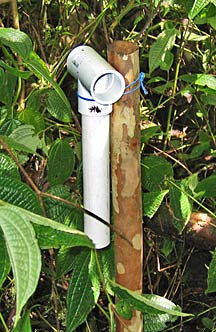Lime OK’d
for use against
coqui frogs
Federal approval for hydrated
lime, which is cheaper than
citric acid, came this week
HILO » The U.S. Environmental Protection Agency has approved the use of hydrated lime to kill coqui frogs in Hawaii for the next three years.
![]()

Lime costs about one-tenth as much as the next-best coqui killer approved to date, citric acid.
"That's good news," said Billy Kenoi, Big Island Mayor Harry Kim's anti-coqui assistant.
The cost of citric acid has been prohibitive for large-scale measures, he said. Hydrated lime, the common name for calcium hydroxide, has been known to be effective against the frogs, but federal, state and county government agencies could not use it without EPA authorization.
The chemical is approved for "amending" excess acidity in soils, and home users who wanted to get rid of coqui frogs had to pretend that was why they were buying it.
Jeff Enriquez-Ikeda, manager of Garden Exchange in Hilo, was pleased with the EPA approval. "Now I can advertise it," he said.
"I've been telling people if they want to 'amend' the forest, go ahead," but people told him they wanted the lime to kill frogs. "OK, but I can't recommend it," he answered. Recommending it as a pesticide would have broken federal law.
His customers knew the effectiveness. While Enriquez-Ikeda bought citric acid by 50-pound bags to stock his store, he was buying lime in lots of a ton or more, he said.
Another word for the action of the lime on acid soil is "sweetening" it. "We've been sweetening soil for quite a while," said Nanette Cothran at Rozett's Nursery, south of Hilo. The nursery is surrounded by coqui-infested land, and the business has struggled to keep them out, she said.
The EPA ruling comes with a "label" -- four pages of instructions for users. The label says the lime is safe enough for use in conservation areas and where endangered plants are present.
Where citric acid could produce dark spots on nursery plants, lime does not. But lime does have dangers.
It "causes irreversible eye damage and skin burns," the label says.
"It's highly corrosive," said Kyle Onuma, the state Department of Agriculture employee who thought of using it as a frog pesticide three years ago on his ginger farm when he realized it was irritating his skin.
State agents who have done field tests with mixtures of hydrated lime and water have dressed head to toe in protective clothing. People should use safety goggles, Onuma said, and the label requires many more precautions.
Purchasers will now have to sign an authorization form every time they buy it and certify that they will read and obey the label.
A few people actually enjoy the high-pitched call of male coquis, but with coquis reaching 12,000 per acre in some places, others are worried about a biological disaster.
"We're very worried about the densities. Our densities here are enormous," said Hawaii County's Kenoi.
The frogs would be a ready-made food supply for the brown tree snake if it ever arrived here from Guam, Kenoi said.
Hawaii County is continuing to seek up to $2 million this legislative session to control the frogs, he said.
Pipe traps can control
frogs without chemicals

|
The frogs climb into the upright pipes, lay their eggs and wait inside for the eggs to hatch. Although the traps are open in three places, the frogs do not move when the traps are picked up, giving people the chance to kill the frogs and eggs with hot water, Hara said.
Death by hot water happens quickly, so it meets requirements of the U.S. Animal Welfare Act, he said.
The T-shaped devices of three-quarter- to 1-inch diameter polyvinyl chloride pipe were invented in the frog's native Puerto Rico to capture them for study.
At Lava Tree State Park south of Hilo, Hara put out a dense array of the PVC traps, 100 in a 66-by-66-foot area. In two weeks he found frogs and eggs in about 30 percent of them. Two weeks later a new crop of frogs had moved in.
The PVC has to be old or weathered to avoid a chemical smell that keeps the frogs away.
www.hawaii.edu
[News] [Business] [Features] [Sports] [Editorial] [Do It Electric!]
[Classified Ads] [Search] [Subscribe] [Info] [Letter to Editor]
[Feedback]
